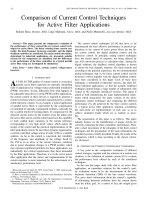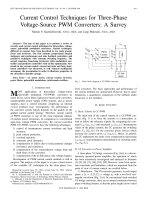Chuong 3c - Chapter 18- Concurrency Control Techniques
Bạn đang xem bản rút gọn của tài liệu. Xem và tải ngay bản đầy đủ của tài liệu tại đây (184.43 KB, 47 trang )
Copyright © 2007 Ramez Elmasri and Shamkant B. Navathe
Slide 18- 1
Chapter 18
Concurrency Control Techniques
Copyright © 2007 Ramez Elmasri and Shamkant B. Navathe
Chapter 18 Outline
Databases Concurrency Control
1.
2.
3.
4.
5.
6.
Purpose of Concurrency Control
Two-Phase locking
Limitations of CCMs
Index Locking
Lock Compatibility Matrix
Lock Granularity
Copyright © 2007 Ramez Elmasri and Shamkant B. Navathe
Slide 18- 3
Database Concurrency Control
1 Purpose of Concurrency Control
To enforce Isolation (through mutual exclusion) among
conflicting transactions.
To preserve database consistency through consistency
preserving execution of transactions.
To resolve read-write and write-write conflicts.
Example:
In concurrent execution environment if T1 conflicts with T2
over a data item A, then the existing concurrency control
decides if T1 or T2 should get the A and if the other
transaction is rolled-back or waits.
Copyright © 2007 Ramez Elmasri and Shamkant B. Navathe
Slide 18- 4
Database Concurrency Control
Two-Phase Locking Techniques
Locking is an operation which secures
Example:
Lock (X). Data item X is locked in behalf of the requesting
transaction.
Unlocking is an operation which removes these permissions
from the data item.
Example:
(a) permission to Read
(b) permission to Write a data item for a transaction.
Unlock (X): Data item X is made available to all other
transactions.
Lock and Unlock are Atomic operations.
Copyright © 2007 Ramez Elmasri and Shamkant B. Navathe
Slide 18- 5
Database Concurrency Control
Two-Phase Locking Techniques: Essential components
Two locks modes:
More than one transaction can apply share lock on X for
reading its value but no write lock can be applied on X by any
other transaction.
Exclusive mode: Write lock (X)
(b) exclusive (write).
Shared mode: shared lock (X)
(a) shared (read)
Only one write lock on X can exist at any time and no shared
lock can be applied by any other transaction on X.
Conflict matrix
Read Read
WriteWrite
Y
N
N
N
Copyright © 2007 Ramez Elmasri and Shamkant B. Navathe
Slide 18- 6
Database Concurrency Control
Two-Phase Locking Techniques: Essential
components
Lock Manager:
Managing locks on data items.
Lock table:
Lock manager uses it to store the identify of
transaction locking a data item, the data item, lock
mode and pointer to the next data item locked. One
simple way to implement a lock table is through
linked list.
Transaction ID Data item id lock mode Ptr to next data item
T1
X1
Read
Next
Copyright © 2007 Ramez Elmasri and Shamkant B. Navathe
Slide 18- 7
Database Concurrency Control
Two-Phase Locking Techniques: Essential
components
Database requires that all transactions should be
well-formed. A transaction is well-formed if:
It must lock the data item before it reads or writes to
it.
It must not lock an already locked data items and it
must not try to unlock a free data item.
Copyright © 2007 Ramez Elmasri and Shamkant B. Navathe
Slide 18- 8
Database Concurrency Control
Two-Phase Locking Techniques: Essential components
The following code performs the lock operation:
B:if LOCK (X) = 0 (*item is unlocked*)
then LOCK (X) 1 (*lock the item*)
else begin
wait (until lock (X) = 0) and
the lock manager wakes up the transaction);
goto B
end;
Copyright © 2007 Ramez Elmasri and Shamkant B. Navathe
Slide 18- 9
Database Concurrency Control
Two-Phase Locking Techniques: Essential
components
The following code performs the unlock operation:
LOCK (X) 0 (*unlock the item*)
if any transactions are waiting then
wake up one of the waiting the transactions;
Copyright © 2007 Ramez Elmasri and Shamkant B. Navathe
Slide 18- 10
Database Concurrency Control
Two-Phase Locking Techniques: Essential components
The following code performs the read operation:
B: if LOCK (X) = “unlocked” then
begin LOCK (X) “read-locked”;
no_of_reads (X) 1;
end
else if LOCK (X) “read-locked” then
no_of_reads (X) no_of_reads (X) +1
else begin wait (until LOCK (X) = “unlocked” and
the lock manager wakes up the transaction);
go to B
end;
Copyright © 2007 Ramez Elmasri and Shamkant B. Navathe
Slide 18- 11
Database Concurrency Control
Two-Phase Locking Techniques: Essential components
The following code performs the write lock operation:
B: if LOCK (X) = “unlocked” then
begin LOCK (X) “read-locked”;
no_of_reads (X) 1;
end
else if LOCK (X) “read-locked” then
no_of_reads (X) no_of_reads (X) +1
else begin wait (until LOCK (X) = “unlocked” and
the lock manager wakes up the transaction);
go to B
end;
Copyright © 2007 Ramez Elmasri and Shamkant B. Navathe
Slide 18- 12
Database Concurrency Control
Two-Phase Locking Techniques: Essential components
The following code performs the unlock operation:
if LOCK (X) = “write-locked” then
begin LOCK (X) “unlocked”;
wakes up one of the transactions, if any
end
else if LOCK (X) “read-locked” then
begin
no_of_reads (X) no_of_reads (X) -1
if no_of_reads (X) = 0 then
begin
LOCK (X) = “unlocked”;
wake up one of the transactions, if any
end
end;
Copyright © 2007 Ramez Elmasri and Shamkant B. Navathe
Slide 18- 13
Database Concurrency Control
Two-Phase Locking Techniques: Essential components
Lock conversion
Lock upgrade: existing read lock to write lock
if Ti has a read-lock (X) and Tj has no read-lock (X) (i j) then
convert read-lock (X) to write-lock (X)
else
force Ti to wait until Tj unlocks X
Lock downgrade: existing write lock to read lock
Ti has a write-lock (X) (*no transaction can have any lock on X*)
convert write-lock (X) to read-lock (X)
Copyright © 2007 Ramez Elmasri and Shamkant B. Navathe
Slide 18- 14
Database Concurrency Control
Two-Phase Locking Techniques: The algorithm
Two Phases:
(a) Locking (Growing)
(b) Unlocking (Shrinking).
Locking (Growing) Phase:
A transaction applies locks (read or write) on desired data items
one at a time.
Unlocking (Shrinking) Phase:
A transaction unlocks its locked data items one at a time.
Requirement:
For a transaction these two phases must be mutually exclusively,
that is, during locking phase unlocking phase must not start and
during unlocking phase locking phase must not begin.
Copyright © 2007 Ramez Elmasri and Shamkant B. Navathe
Slide 18- 15
Database Concurrency Control
Two-Phase Locking Techniques: The algorithm
T1
T2
Result
read_lock (Y);
read_item (Y);
unlock (Y);
write_lock (X);
read_item (X);
X:=X+Y;
write_item (X);
unlock (X);
read_lock (X);
read_item (X);
unlock (X);
Write_lock (Y);
read_item (Y);
Y:=X+Y;
write_item (Y);
unlock (Y);
Initial values: X=20; Y=30
Result of serial execution
T1 followed by T2
X=50, Y=80.
Result of serial execution
T2 followed by T1
X=70, Y=50
Copyright © 2007 Ramez Elmasri and Shamkant B. Navathe
Slide 18- 16
Database Concurrency Control
Two-Phase Locking Techniques: The algorithm
T1
T2
read_lock (Y);
read_item (Y);
unlock (Y);
Time
write_lock (X);
read_item (X);
X:=X+Y;
write_item (X);
unlock (X);
read_lock (X);
read_item (X);
unlock (X);
write_lock (Y);
read_item (Y);
Y:=X+Y;
write_item (Y);
unlock (Y);
Copyright © 2007 Ramez Elmasri and Shamkant B. Navathe
Result
X=50; Y=50
Nonserializable because it.
violated two-phase policy.
Slide 18- 17
Database Concurrency Control
Two-Phase Locking Techniques: The algorithm
T’1
T’2
read_lock (Y);
read_item (Y);
write_lock (X);
unlock (Y);
read_item (X);
X:=X+Y;
write_item (X);
unlock (X);
read_lock (X);
read_item (X);
Write_lock (Y);
unlock (X);
read_item (Y);
Y:=X+Y;
write_item (Y);
unlock (Y);
Copyright © 2007 Ramez Elmasri and Shamkant B. Navathe
T1 and T2 follow two-phase
policy but they are subject to
deadlock, which must be
dealt with.
Slide 18- 18
Database Concurrency Control
Two-Phase Locking Techniques: The algorithm
Two-phase policy generates two locking algorithms
(a) Basic
(b) Conservative
Conservative:
Prevents deadlock by locking all desired data items before
transaction begins execution.
Basic:
Transaction locks data items incrementally. This may cause
deadlock which is dealt with.
Strict:
A more stricter version of Basic algorithm where unlocking is
performed after a transaction terminates (commits or aborts and
rolled-back). This is the most commonly used two-phase locking
algorithm.
Copyright © 2007 Ramez Elmasri and Shamkant B. Navathe
Slide 18- 19
Database Concurrency Control
Dealing with Deadlock and Starvation
Deadlock
T’1
T’2
read_lock (Y);
read_item (Y);
T1 and T2 did follow two-phase
policy but they are deadlock
read_lock (X);
read_item (Y);
write_lock (X);
(waits for X)
write_lock (Y);
(waits for Y)
Deadlock (T’1 and T’2)
Copyright © 2007 Ramez Elmasri and Shamkant B. Navathe
Slide 18- 20
Database Concurrency Control
Dealing with Deadlock and Starvation
Deadlock prevention
A transaction locks all data items it refers to before
it begins execution.
This way of locking prevents deadlock since a
transaction never waits for a data item.
The conservative two-phase locking uses this
approach.
Copyright © 2007 Ramez Elmasri and Shamkant B. Navathe
Slide 18- 21
Database Concurrency Control
Dealing with Deadlock and Starvation
Deadlock detection and resolution
In this approach, deadlocks are allowed to happen. The
scheduler maintains a wait-for-graph for detecting cycle. If
a cycle exists, then one transaction involved in the cycle is
selected (victim) and rolled-back.
A wait-for-graph is created using the lock table. As soon as
a transaction is blocked, it is added to the graph. When a
chain like: Ti waits for Tj waits for Tk waits for Ti or Tj
occurs, then this creates a cycle. One of the transaction o
Copyright © 2007 Ramez Elmasri and Shamkant B. Navathe
Slide 18- 22
Database Concurrency Control
Dealing with Deadlock and Starvation
Deadlock avoidance
There are many variations of two-phase locking algorithm.
Some avoid deadlock by not letting the cycle to complete.
That is as soon as the algorithm discovers that blocking a
transaction is likely to create a cycle, it rolls back the
transaction.
Wound-Wait and Wait-Die algorithms use timestamps to
avoid deadlocks by rolling-back victim.
Copyright © 2007 Ramez Elmasri and Shamkant B. Navathe
Slide 18- 23
Database Concurrency Control
Dealing with Deadlock and Starvation
Starvation
Starvation occurs when a particular transaction consistently
waits or restarted and never gets a chance to proceed
further.
In a deadlock resolution it is possible that the same
transaction may consistently be selected as victim and
rolled-back.
This limitation is inherent in all priority based scheduling
mechanisms.
In Wound-Wait scheme a younger transaction may always
be wounded (aborted) by a long running older transaction
which may create starvation.
Copyright © 2007 Ramez Elmasri and Shamkant B. Navathe
Slide 18- 24
Database Concurrency Control
Timestamp based concurrency control algorithm
Timestamp
A monotonically increasing variable (integer)
indicating the age of an operation or a transaction.
A larger timestamp value indicates a more recent
event or operation.
Timestamp based algorithm uses timestamp to
serialize the execution of concurrent transactions.
Copyright © 2007 Ramez Elmasri and Shamkant B. Navathe
Slide 18- 25









